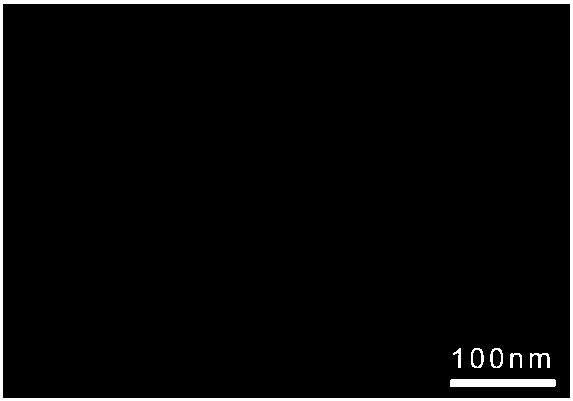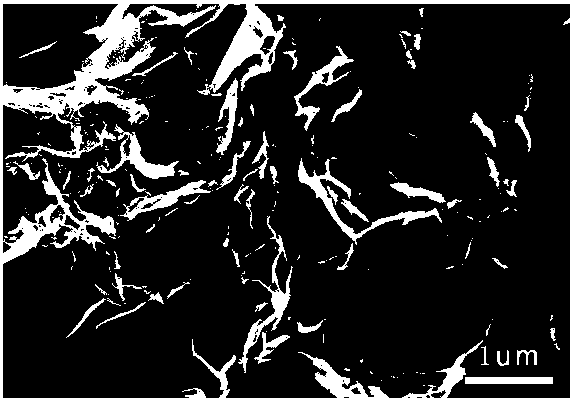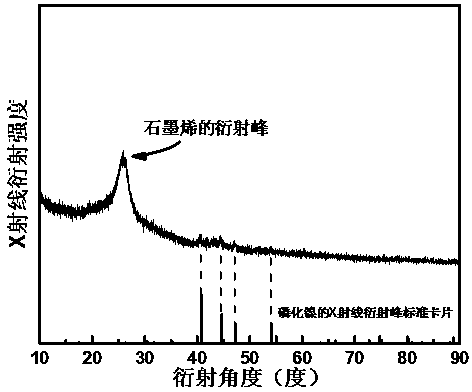A preparation method of lithium-sulfur battery cathode material based on phosphorus-doped graphene-loaded nickel phosphide material
A phosphorus-doped graphene, lithium-sulfur battery technology, applied in battery electrodes, lithium storage batteries, non-aqueous electrolyte storage batteries, etc., can solve the problems of poor reaction material activity and short positive electrode cycle life, and achieve the effect of suppressing volume expansion
- Summary
- Abstract
- Description
- Claims
- Application Information
AI Technical Summary
Problems solved by technology
Method used
Image
Examples
Embodiment 1
[0023] (1) Take 10 mL of 0.2 mg / mL graphene oxide, add 1 mg of hexadecyltrimethylammonium bromide to it, and stir magnetically to obtain a graphene oxide dispersion.
[0024] (2) Add 10mmol of nickel sulfate and 10mmol of sodium hydroxide into 5mL of distilled water, and stir magnetically to obtain a salt solution.
[0025] (3) Slowly add the salt solution in step (2) to the graphene oxide dispersion in step (1) under vigorous stirring, and keep stirring for 5 minutes, then transfer to the reaction kettle, and place in an oven at 140°C After reacting for 6 hours, the obtained product was filtered and freeze-dried to obtain a graphene composite material loaded with nickel precursor.
[0026] (4) Mix the nickel precursor-loaded graphene composite obtained in step (3) with potassium hypophosphite at a mass ratio of 1:1, and calcinate phosphide 1 at a temperature of 250°C in an argon atmosphere tube furnace. hours, phosphorus-doped graphene-supported nickel phosphide material was...
Embodiment 2
[0033] (1) Take 1000 mL of 10 mg / mL graphene oxide, add 200 mg of Triton X100 to it, and stir magnetically to obtain a graphene oxide dispersion.
[0034] (2) Add 1000mmol of nickel hypophosphite and 1000mmol of urea into 50mL of distilled water, and stir magnetically to obtain a salt solution.
[0035] (3) Slowly add the salt solution in step (2) to the graphene oxide dispersion in step (1) under vigorous stirring, and keep stirring for 100 minutes, then transfer to the reaction kettle, and place in an oven at 250°C After reacting for 24 hours, the obtained product was obtained by filtration after the reaction was completed, and freeze-dried to obtain a graphene composite material loaded with nickel precursor.
[0036] (4) Mix the nickel precursor-loaded graphene composite material obtained in step (3) with yellow phosphorus at a mass ratio of 1:50, and calcine phosphating at a temperature of 800 ° C in a helium atmosphere tube furnace for 12 hours , to obtain phosphorus-dop...
Embodiment 3
[0039] (1) Take 20 mL of 5 mg / mL graphene oxide, add 150 mg of polyvinyl alcohol to it, and stir magnetically to obtain a graphene oxide dispersion.
[0040] (2) Add 800mmol of nickel acetate and 40mmol of ammonia water to 30mL of distilled water, and stir magnetically to obtain a salt solution.
[0041](3) Slowly add the salt solution in step (2) to the graphene oxide dispersion in step (1) under vigorous stirring, and keep stirring for 80 minutes, then transfer to the reaction kettle, and place in an oven at 200°C After reacting for 12 hours, the obtained product was filtered and freeze-dried to obtain a graphene composite material loaded with nickel precursor.
[0042] (4) Mix the nickel precursor-loaded graphene composite material obtained in step (3) with sodium hypophosphite at a mass ratio of 1:10, and calcine phosphating at a temperature of 500°C in a nitrogen atmosphere tube furnace for 9 hours , to obtain phosphorus-doped graphene-supported nickel phosphide material...
PUM
 Login to View More
Login to View More Abstract
Description
Claims
Application Information
 Login to View More
Login to View More - R&D
- Intellectual Property
- Life Sciences
- Materials
- Tech Scout
- Unparalleled Data Quality
- Higher Quality Content
- 60% Fewer Hallucinations
Browse by: Latest US Patents, China's latest patents, Technical Efficacy Thesaurus, Application Domain, Technology Topic, Popular Technical Reports.
© 2025 PatSnap. All rights reserved.Legal|Privacy policy|Modern Slavery Act Transparency Statement|Sitemap|About US| Contact US: help@patsnap.com



